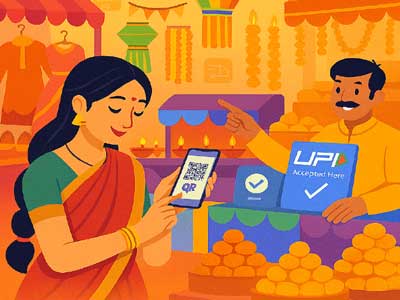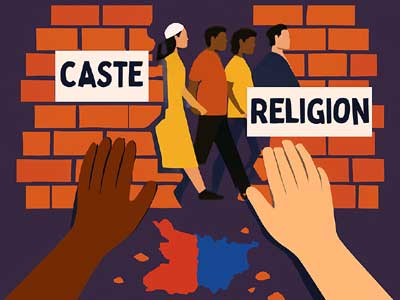At Taj View Apartments in Agra, homemaker Padmini was busy preparing for Diwali. Fed up with traffic jams and pollution, she spotted an online Diwali deal late in the evening and clicked ‘Order Now’. Little did she know she was becoming part of India’s new retail story! Within minutes, flowers, lamps, lights, fruits, and sweets, all neatly packed, arrived at her doorstep. A young biker delivered the goods, took a UPI payment, and rode off.
Meanwhile, across town, her elder uncle, who runs a general store, was busy managing a rush of customers. Two generations, one festival, and one clear message: India’s festive economy is now dancing to a digital beat.
Read in Hindi: डिजिटल ताल पर थिरक रहा है भारत का त्योहारी व्यापार
Truly, it feels like magic! Once, shopkeepers feared online stores, but this Diwali broke all records. The 2025 festive season saw trade worth ₹6.05 lakh crore, 25 per cent higher than last year! Of this, ₹5.4 lakh crore came from goods and ₹65,000 crore from services. But behind this explosive growth wasn’t gold or gadgets; it was digital power spreading retail to every lane and corner of India.
Earlier, traditional markets and online platforms were seen as rivals. But now? They’re performing together in a grand new show, from dusty bazaars to gleaming smartphone screens. Flash sales, cashback offers, and local grocers, chemists, and provision stores stepping into the digital world, festive fervour now flows through internet lines and satellite waves as much as through bustling markets.
As Devashish jokes, “All we’re waiting for now is home delivery of liquor! Condoms and sanitary napkins, once bought shyly, are now arriving at doorsteps.”
According to RedSeer data, e-commerce sales this festive month crossed ₹1.15 lakh crore, up 25 per cent from last year. And instead of hurting offline stores, online trade is boosting demand in smaller towns, Tier-2 and Tier-3 cities, now deeply connected to the digital world.
People once thought online shopping would destroy traditional markets, but it’s now the heartbeat of consumer excitement. In 2024, India’s e-retail sales stood at about $60 billion, growing at 18 per cent annually. Flipkart, Amazon, Meesho, and JioMart turned this Diwali into a digital carnival. From Jammu to Mysuru, people hunted for festive deals on their phones. Quick-commerce services cut delivery times by 15 per cent, bringing gifts, hampers, and electronics almost instantly. Far from weakening traditional stores, this digital surge has amplified their buzz, flooding showrooms and streets with shoppers.
And yet, the old-world charm of markets remains! From Delhi’s Chandni Chowk to Agra, Jaipur, and Hyderabad, traders told the media that customer footfall this year was the highest in many years.
Sales rose by 25 per cent for clothing, 30 per cent for jewellery, 20 per cent for electronics, and 15 per cent for daily goods. GST relaxations and rising incomes added to the festive cheer. But this time, digital tools quietly played a starring role; small shopkeepers were sending catalogues via WhatsApp, taking UPI payments, and managing orders through delivery apps.
Courier operator Gupta ji says the logistics network supporting this digital festival was phenomenal. Millions of gig workers, delivery riders, warehouse packers, and transport handlers became the real backbone of the season. An estimated five million temporary jobs were created, offering many people seasonal income and opportunities in cities. Thousands of students found part-time work.
And, the most interesting part? The spirit is no longer one of competition, but collaboration. Sweet makers, grocers, and local vendors are now partnering with e-commerce platforms, leveraging digital inventories and local delivery networks to thrive together.
Now, as the country steps into the grand wedding season, with an expected ₹6 lakh crore in trade, one thing is clear: online commerce isn’t erasing traditional markets; it’s giving them new life. The digital marketplace, once feared, has become the engine driving festive prosperity, linking millions of livelihoods, and blending celebration with commerce in a powerful hybrid rhythm, says Noida trader Ravi Chandra.
Indeed, in today’s India, the light of Diwali diyas glows not only in homes and streets, but also across millions of screens, illuminating the most dynamic retail story the nation has ever seen.


















Related Items
Redefining Indian Highways; Driving innovation, Delivering connectivity…
India stuck in traffic; Cities halt, Horns holler, and time takes a nap
India’s deep dark fraud economy unveiled…